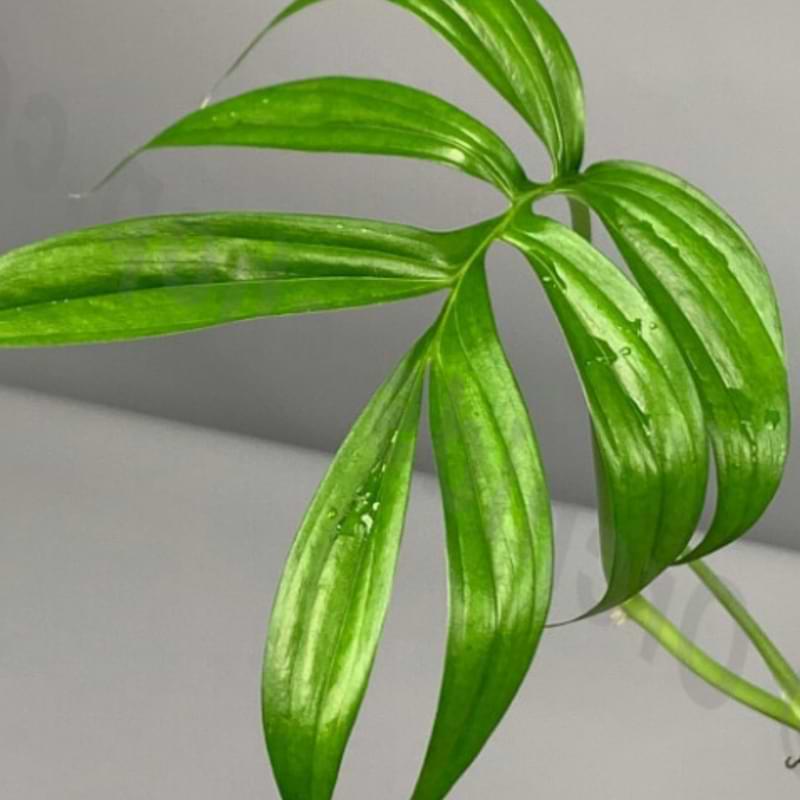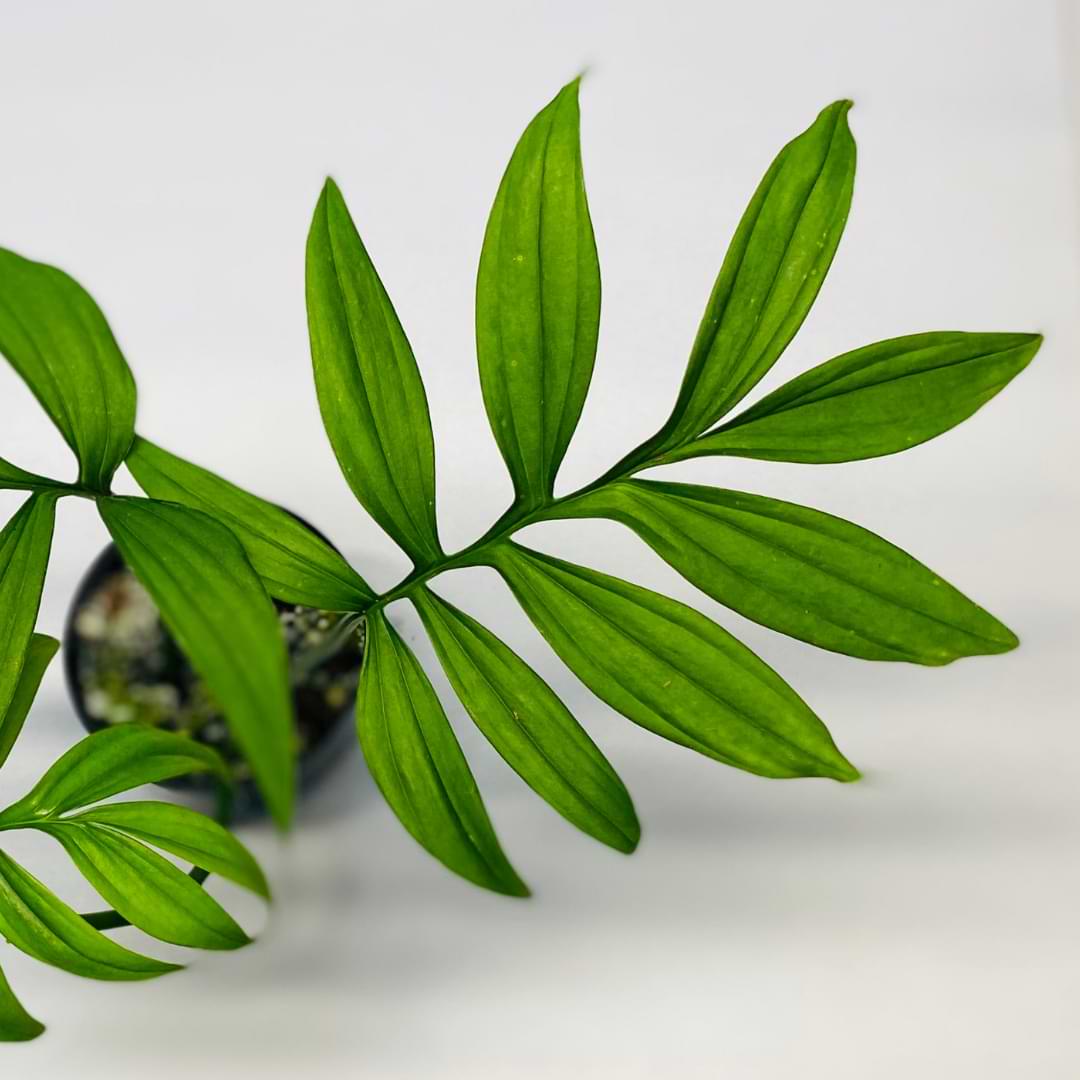Monstera subpinnata is a beautiful, less common variety of monstera plant that might look a lot different from what you might usually think when you hear “monstera.”
Many monstera varieties, like the iconic Monstera deliciosa or the dainty but striking Monstera adansonii, are known for their fenestrated leaves. But the leaves of Monstera subpinnata are actually an example of pinnate foliage, with pairs of leaflets symmetrically on either side of the stem.
These gorgeous leaves can reach up to a foot long and 8 inches wide when mature. Try Monstera subpinnata if you’re interested in a vining plant that climbs like a monstera but with sectioned, frond-like leaves reminiscent of a parlor palm.
This can make for a different kind of tropical look than you would get from a fenestrated monstera!
This variety is native to Ecuador and can reach 30 feet tall in the wild. However, it will only grow to around 6 feet indoors, and that’s only if they have something to climb. Otherwise, your plant will grow horizontally and splayed outward, which can get a little unruly!
If you’ve cared for other monstera varieties or even other tropical houseplants, you should have very little trouble caring for a Monstera subpinnata.
Here’s what you need to know to grow one of these beautiful plants indoors!
Table of Contents
Monstera Subpinnata Care
Position and Humidity
One of the most important parts of growing a healthy Monstera subpinnata is creating the ideal light conditions and humidity levels.
Monstera subpinnata thrives in bright, indirect sunlight much like it would receive in the tropics under the rainforest canopy. An east-facing window is an ideal position because your plant will receive lots of bright sunlight all day and maybe even a little direct sun before 10:00 a.m., but no direct midday or afternoon sunlight. This is great because harsh, direct sun can burn Monstera subpinnata’s delicate leaves!
A south- or west-facing window can also work, but make sure to place your plant a few feet away where the sun’s rays won’t fall directly on the leaves. You can also filter the sunlight with a sheer curtain to avoid leaf scorch.
In most cases, a north-facing window won’t provide enough light to allow a Monstera subpinnata to thrive, but if you have no other option, no worries! You can supplement with full-spectrum grow lights. We love these bulbs that you can simply screw into regular light fixtures!
Since the leaves of Monstera subpinnata are so slender and delicate, they require quite a bit of humidity to stay soft and supple. If you live in a dry area or if the humidity in your space is lower than 50%, you might want to set up a humidifier near your plant. You can also mist the plant daily. Or, if your plant is still small, set the pot on a humidity tray. You can buy these ready to go at garden centers or make your own DIY version by filling a shallow tray with water and pebbles. Then just place the plant on top so it can enjoy a little extra humidity as the water evaporates. (Just make sure the roots and soil don’t touch the water!)
Another great option is to put the plant in a bright, steamy bathroom or to group it with other plants, which will create a little more humidity as they respire.
And of course, watch out for factors that could potentially cause your plant to dry out, like heating/air-conditioning vents, drafts, space heaters, etc.
Temperature
Remember, Monstera subpinnata is a tropical plant, so it likes warm temperatures! Keep indoor temperatures between 65 and 80 degrees Fahrenheit, and don’t let them drop below 60. Watch out for drafts that can freeze the leaves as well as blasts of hot air that could dry out and scorch your plant’s leaves. The more consistent the temperature, the happier your plant will be!
Watering
These plants like constantly damp but not soggy soil. It’s best to water when the top few inches of soil feel dry to the touch, or when a moisture meter reads 3-4.
We highly recommend a moisture meter, by the way, because it gives you a more accurate look at what’s happening deeper in the pot. Depending on how well your pot and soil drain, it’s possible for the top of the soil to be completely dried out while the root ball is still soggy!
This is the meter we use and recommend. As an added bonus, it also measures light levels and soil pH!
When it’s time to give your Monstera subpinnata a drink, slowly add water to the top of the soil until it just starts to drain out the bottom. Then empty the drainage trays right away or place the plant in the sink or tub to let it drain for an hour or two (or even longer!).
You should be watering your Monstera subpinnata every 7-10 days. If it takes longer than that for the soil to dry out, your potting medium might be too dense, the pot may not be draining correctly, or your plant might need more light so it can use water more efficiently.
If the soil dries out before then, you may be watering too lightly. Make sure the water drains out the bottom when you water!
Soil
Plant your Monstera subpinnata in a potting medium that drains well and has a neutral pH. Cactus mix with a little peat moss and perlite mixed in can work well, and we also love this DIY aroid recipe from Kaylee Ellen on YouTube.
You can also grow this and other monstera varieties in hydroponic or semi-hydroponic growing mediums like LECA!
Our favorite potting medium for Monstera subpinnata and other monstera varieties is our Premium Monstera Potting Soil. It’s the perfect balance of drainage and moisture retention for monsteras and other aroids, and the pH and nutritional content are ideal for giving your plant a great start once you pot it. The best part is, it’s ready to go right out of the bag, so you won’t have to mix or add any special ingredients!
Get Monstera Potting Soil on Amazon.
Fertilizing
A Monstera subpinnata can use up all the nutrients in its potting mix in just a few months, so make sure to keep your plant well-nourished with a balanced, high-quality liquid fertilizer.
We recommend Monstera Plant Food because it’s specifically formulated for all varieties of monstera with an ideal N-P-K ratio of 5-2-3, which supports optimal root formation, stem development, and leaf growth. The best part is, it’s gentle enough to use with each watering, so you won’t have to remember a fertilization schedule!
Fertilize with every watering during the spring and summer, and half as much in the fall. You can take a break during the winter when your Monstera subpinnata is most likely dormant and not actively growing.
Get Monstera Plant Food on Amazon!
Repotting
Monstera subpinnata is a fairly fast-growing plant, so make sure to repot every year to give your plant’s roots a chance to spread out so the plant can keep growing! This will also give you a chance to refresh the soil, which will not only replenish your plant’s nutrient supply but will also prevent the soil from getting old and compacted (which can lead to issues with drainage and water absorption simultaneously!).
When you repot, go up a pot size, or select a pot that’s 2-3 inches larger in diameter than your plant’s root ball. And make sure it has drainage holes!
To repot, start by gently unpotting your plant. Tip the old pot on its side and carefully coax the plant out with your fingers or even with a trowel or butter knife. Massage as much of the old soil out of the root ball as possible.
Place a few inches of soil in the bottom of the new pot and place the plant in the center of the pot. Fill in the sides and top with more soil. Water thoroughly and let drain, then add a little more soil to the top to compensate for settling. Make sure to leave an inch or two of headroom for watering!

How to Propagate Monstera Subpinnata
Monstera Subpinnata Runner
Monstera subpinnata plants put out runners, which look like extra stems or vines growing from the main growth point on the parent plant. These runners can give the plant a messy look, so you might be tempted to just cut them off and throw them away.
These runners typically have nodes on them, and might have small leaves, so you can actually propagate these to produce a clone of the parent plant!
There are a few ways to propagate your Monstera subpinnata runners. Sometimes the nodes might put out roots on their own. You can simply cut these off and pot them up right away.
You can also air layer to encourage the runner to produce roots at the node as well. To do this, use a sharp, clean knife or shears to carefully make a tiny cut or scratch in the stem near the node. Then wrap the wound in a little damp sphagnum moss and wrap in plastic wrap, then secure the whole bundle with string or a twist tie. Within a few weeks, the runner might have started to put out roots!
Once you see some roots, you can cut off that section of stem and plant it in soil. Just make sure that the end of the stem that was facing the parent plant is in the soil. You don’t want to plant it upside down!
FAQ Are Monstera Subpinnata Rare?
While these plants aren’t super common in garden centers and big home improvement stores like Lowe’s or IKEA, they are fairly easy to find in online shops and on Etsy. They’re also fairly affordable! If you have your heart set on a Monstera subpinnata, you shouldn’t have too much trouble locating one.
FAQ What’s the Difference Between Monstera Subpinnata and Monstera Pinnatipartita?
Monstera subpinnata can sometimes look similar to another monstera species, monstera pinnatipartita.
It’s easiest to tell these plants apart when they’re older. The leaves of a mature pinnatipartita do not separate into “fingers” or separate leaflets but remain connected at the tips. Therefore, the leaves are more fenestrated like other monstera varieties rather than pinnated like subpinnata leaves.
Add a Monstera Subpinnata to Your Collection!
With its unique leaves and fairly simple care requirements, Monstera subpinnata is a great potential addition to your houseplant collection!
Check out these resources to improve your monstera care skills and knowledge and grow the most beautiful monstera plants around!





